Complexity in ISFA (in-service fluid analysis): Part XVII
Jack Poley | TLT On Condition Monitoring July 2014
An update in holistic condition monitoring.
WE’LL NOW DISCUSS WIND TURBINES, as in the previous column I referred to a recent installation of sensors that took place at The U.S. Department of Energy’s National Renewable Energy Laboratory* (NREL) near Boulder, Colo. NREL has a number of wind turbines of various manufacture and output for experimental and data cataloging purposes.
The location selected is very unique in terms of wind velocity and gusts, which can be combinations of varied, severe and unpredictably sudden; thus this location is an ideal outdoor laboratory for achieving maximum stress under rapidly changing wind conditions. Following is a description and discussion of this installation. On a personal note, I’m proud and excited to be associated with respect to data assessment and evaluation support.
Additionally there are two large test dynamometers in separate buildings with capacities of 2.5 and 5 megawatts, respectively, allowing wind turbine type gearsets of wide capacity to be programmably exercised. Objectives include basic data gathering and modeling, stressing the gearset beyond its rated load capacity to assess machine integrity and noting the kinds of trauma that may be induced. The sensor installation referenced in this column is on the 2.5 MW dyno.
The Parker-Kittiwake/Parker-Holroyd 2nd generation sensors installation (
see Figure 1):
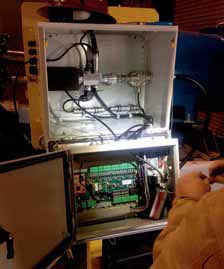 Figure 1.
Figure 1.
Figure 2 shows the metal sensor housing (suite) wherein the following are mounted:
•
Oil (lube) moisture sensor (MS) and environmental sensor – relative humidity
•
Ferrous wear debris magnetometric particle counter (FDPC)
•
Oil (lube) condition sensor – dielectric (OCS)
•
Electronics, including a T-MAC data collector and acoustic emission (ultrasonic) sensor termination points.
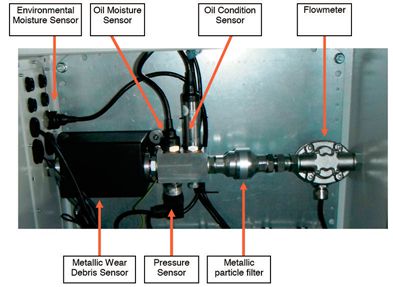 Figure 2.
Figure 2.
Figures 3 and 4 show the dynamometer and gearset/drive, respectively. The technician is running power feeds to the sensor suite, mounted on the yellow stand.
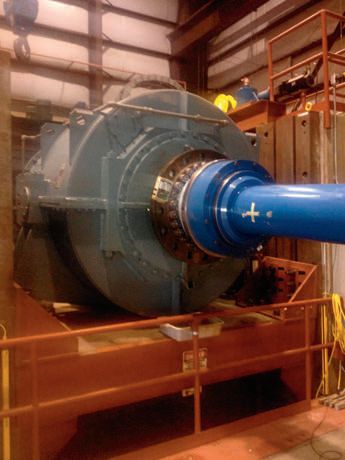 Figure 3.
Figure 3.
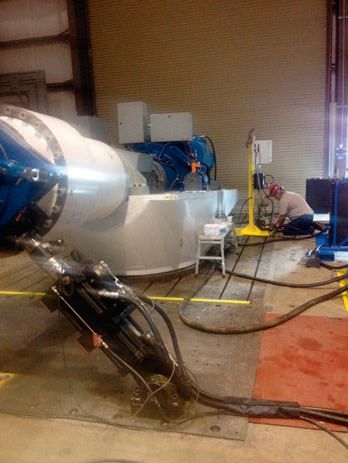 Figure 4.
Figure 4.
Figures 5 and 6 show typical installation locations for surface-mounted acoustic emission sensors (Parker-Holroyd). Five acoustic emission sensors were installed on the main bearing, ring gear and the three separate gearsets.
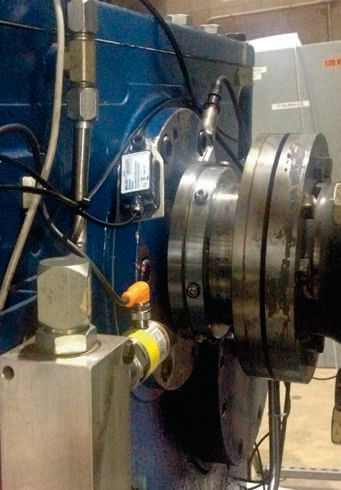 Figure 5.
Figure 5.
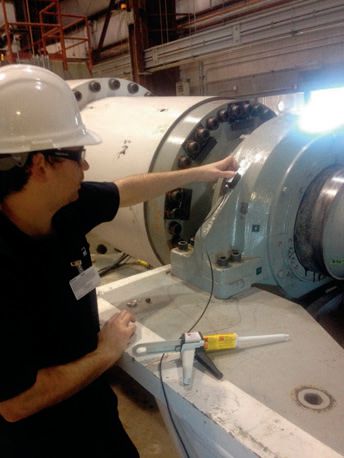 Figure 6.
SETUP
Figure 6.
SETUP
Because we now have the relative luxury of real-time lube property and contamination measurements to be integrated with vibration (courtesy of yet another vendor) and acoustic emission data, a truly holistic live monitoring of the gearset and bearing via three different CM techniques is enabled.
A rare opportunity is presented up to this point in time with respect to exploring synergistic relationships with unrelated methods. It stands to reason that correlation between any two, and especially of all three CM approaches utilized would be the closest thing to a slam-dunk one might expect to observe.
A recognized laboratory is also performing routine ISFA, providing another possible pivot point in data rating and timeline inferences.
Numbers of us are interested in the so-named Holy Grail of ISFA and CM, generally, i.e., knowing what issues are in play as they begin to develop in order to blunt them well in advance of a downtime event. This is something that surely has to occur at the machine. While this type of save routinely occurs without such a sophisticated installation as shown herein, it will occur much more frequently when the onset of a problem is divined at earliest opportunity, thus exploiting the notion set forth in Moubry’s P-F curve (discussed several times in earlier articles). The more advance notice obtained, the better and more effective the response.
There is an additional advantage to having the earliest warning possible—root cause is easier to identify before secondary effects and damage cloud the matter.
DATA
Who (maybe what) is going to analyze all these different data and amalgamate them into a useful composite opinion and advisory? Several smart people, domain experts (DEs), will be looking at these data and I’ll bet a considerable sum there will be times when these DEs don’t agree on the implication of a particular combination of data. Perhaps not 180 degrees out of phase, but different nonetheless. Regardless, the referee will be the machine’s condition at any point in time from perfect performance to issues and possible failure, as contrasted with the DEs’ speculations and opinions.
Then, too, there will be an Intelligent Agent (IA) in play such that combinations of data that seem to correlate will be spotted, even if there are no rules for such combinations, for that is the time to start looking for some. The IA is programmed to be relentless (suspicious) when coincidences occur. Sometimes it spots combinations that the DE can dismiss out of hand. Most often, the DE will be appreciative of the IA’s vigilance and write a rule. Again, the machine’s condition over time is the vetting mechanism and does one of three things: confirms the rule, contradicts the rule or does not conform to the rule (a neutral event).
The IA will also incorporate any vetted rules that the DEs develop, preserving the knowledge for future evaluations and for training future DEs.
ALL GOOD THINGS IN TIME
If I have one early disappointment in this project, it’s that we have only one gearset to play with. Likely trauma will develop since the test team is going to deliberately stress the machine. But even if everything goes the best it possibly can, there still is only one machine under evaluation, and it would be dangerous to draw every possible conclusion and promote every speculative thought that presents itself or seems to.
Clearly this is still a great opportunity to explore the CM
holistic process but it is a stepping-stone, not a bridge that we’re constructing. One has to start somewhere and as I noted before, I’m very pleased to be in the mix of things regarding the IA and the DEs I’ll be integrating with during this project.
I hope to share some of these data and the advisories in a future column at about this time next year when we will hopefully have had at least one detectable event and a success story of some kind, accordingly.
(
All photos taken by the author, with permission from NREL.)
 Jack Poley is managing partner of Condition Monitoring International (CMI), Miami, consultants in fluid analysis. You can reach him at jpoley@conditionmonitoringintl.com
Jack Poley is managing partner of Condition Monitoring International (CMI), Miami, consultants in fluid analysis. You can reach him at jpoley@conditionmonitoringintl.com.
For more information about CMI, visit www.conditionmonitoringintl.com.